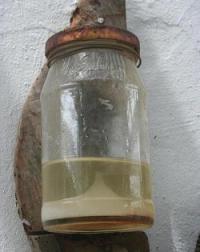
Shark Oil Barometer during a hurricane
Photo: Ronnie Chameau
One of the earliest and best ways of predicting the weather was the barometer. The first to measure changes in atmospheric pressure was developed by Evangelista Torricelli in 1643. By 1668 Robert Hooke recognized that a barometer could foretell storms at sea. The odd thing is that there are several very different types of barometers that bear almost no resemblance to the marine barometer. One of the more interesting is the Bermudian shark oil barometer, which is said to predict the weather, even if no one is quite sure how.
Bermudian shark oil barometers are made by putting a small amount of oil extracted from a shark liver, sealed in glass. They are often small jars or even clear wine or liquor bottles. They can be seen hanging outside homes across Bermuda and are said to be able to predict the weather with a reasonable degree of accuracy.
Strictly speaking, the devices are not barometers as they do not react to or measure atmospheric pressure. The “baro” in the word barometer is from the Greek word “baros” meaning weight. Barometers literally measure the weight of the air, which the shark oil “barometers” do not do. They are said to do a number of other amazing things, however.
When the shark oil is clear, the weather will be clear. When the oil turns cloudy, so will the skies. The oil is said to spin when are serious storm or hurricane is on its way. It is also said that the shifting of sediments on the bottom of the jar can also foretell wind direction. In total, there are at least 40 different readable signs that can appear in a given oil barometer according to some Bermudians. The story goes that the shark oil barometers have been in use on the island for close to 300 years.
Beyond anecdotal stories, there has not been much research on the shark oil barometers. In the summer of 2015, Bermuda Institute of Ocean Science (BIOS) scientist Mark Guishard and college intern Shane Antonition tested a methodology for studying the devices using time-lapse photography. In a one week trial they noted no relationship between atmospheric pressure and changes in the the shark oil. They did not changes due to temperature however.
The BIOS blog notes: One downside of the timing of their summer project was that no major storms or weather events hit the island, making it difficult to actually monitor behavior in the oil through a variety of weather events. Among the next steps listed for the project are longer time spans for monitoring the oil under different atmospheric and weather conditions, as well as different seasons; expanded pressure experiments; and chemical testing of the oil, to learn more about its specific behaviors and properties.

Yes many of the ‘elders’ still have and use shark oil barometers and apparently it does work for some ailments – https://www.youtube.com/watch?v=hO7za9zQVnE
fascinating.
Pingback: Shark Oil Barometers – Old Salt BlogOld Salt Blog – R. G. Richardson